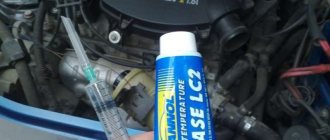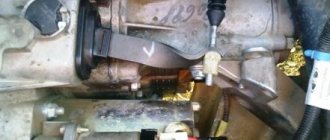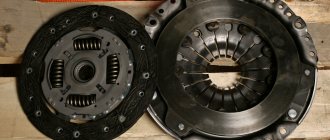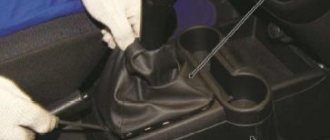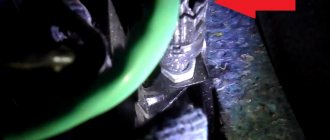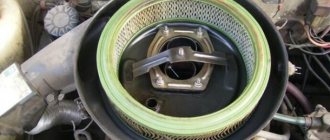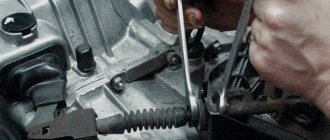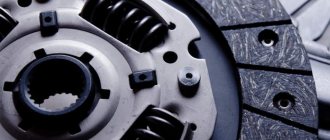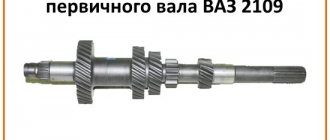The clutch is one of the most loaded mechanisms, designed to connect the gearbox input shaft to the flywheel of the internal combustion engine crankshaft. The clutch is engaged and disengaged by means of the clutch pedal, which can be “connected” to the release bearing mechanically or hydraulically.
One of the common malfunctions on cars with manual transmission is a stiff clutch pedal, when the driver needs to apply noticeable force when pressing. In this case, there may be several reasons why the clutch is tight: fastening of the pedal itself, problems with the clutch drive, malfunctions of the clutch mechanism, etc. Next, we'll look at the signs that indicate a hard clutch pedal is a symptom of a problem, as well as the causes of a tight clutch.
Types of clutch drive
The clutch is not one part of the car, it consists of several parts. Among them: drive/driven discs, release bearing, release clutch, fork, drive, clutch basket. Due to the large number of components, the unit fails faster, but there is also a dependence on its type:
- Cable - is mechanical, the pedal and fork are connected by a cable, which is activated by pressing the foot. The fork presses on the bearing, which opens the discs.
- Hydraulic – bearing pressure is controlled by fluid. The pedal is connected to a hydraulic circuit; when pressed, pressure is created in it. It affects the hydraulics of the release bearing, which opens the discs.
The cable mechanism is simpler in design, but it also breaks more often due to its component parts. There the cable may fray or the bracket may break.
Attention! Even a slight breakdown of the cable assembly will lead to deterioration in pressing. If you do not pay attention to this, the problem will worsen and develop into a serious malfunction.
What to do?
So, your pedal has fallen or is slipping, what to do in such cases? You have no other choice but to solve the problem. You have two options: turn to professionals for help and spend money on a service station, or take the initiative into your own hands and fix the problem yourself. Next, we will tell you how to do it yourself.
Cleaning system elements from oiling
First of all, you need to disconnect the battery, since to clean the flywheel and other elements of the system, you will need to dismantle the gearbox. And since when dismantling the box you will need to disconnect the electrical connectors, the battery should be disconnected. Remove the gearbox. If you do not have enough experience and knowledge for this, then it is better to seek help from a service station. Next, you need to unscrew the screws that secure the flywheel. Try to keep it from turning when you remove the screws. Remove the flywheel and clean it with white spirit or acetone. You can also use gasoline for these purposes. Do similar actions with the pressure and driven disk if these components are oily. Before direct installation, cleaned elements must be wiped dry.
Please note: if the driven shaft is too oily, it would be more advisable to replace it, since in practice cleaning the element rarely helps. It is also necessary to eliminate the cause of the oiling. In VAZ 2110 cars, oil leaks can occur through the gearbox or engine seals. Reassemble everything in reverse order.
Clutch replacement
One of the reasons why the pedal fails may be the inoperability of the clutch.
- After removing the gearbox using a wrench, you will need to unscrew the six bolts that secure the clutch housing to the flywheel. If you have difficulty unscrewing the screws, tap the heads with a hammer. The screws must be unscrewed evenly, not one by one.
- Having done this, you can dismantle the driven and drive shafts. If you see mechanical damage on these elements, then, most likely, the clutch is slipping precisely because of this. You need to change disks.
- Install a new mechanism. In this case, the driven shaft must be installed with the protruding side facing the drive pulley. Mount the centering mandrel.
- Insert the frame into the crankshaft hole. In this position you need to secure the drive pulley of the device. Again, this should be done evenly, tightening the screws one turn at a time rather than one at a time.
Drive replacement and adjustment
- If the pedal in your VAZ 2110 has failed or is slipping, then one of the most common reasons for this may be a failed cable. To replace the cable, you need to remove it from its installation location, namely the bracket, which is installed directly on the gearbox.
- Unscrew the nuts that secure the cable to the bracket. To do this, you will need wrenches 2 and 19. Loosen the bolts and remove one part of the cable from the installation location. After this, it must be disengaged from the fork, which engages the clutch.
- Now the cable must be disconnected from the pedal. Open the hood and locate the cable housing, which is located next to the vacuum brake booster. The casing must be removed, but before doing this, unscrew the fastening bolt with a Phillips screwdriver. Next, pry up with a screwdriver and remove the locking bracket. After this, the cable can be removed.
- Perform a visual inspection of the bushing onto which the cable is attached. If excessive wear occurs, this component must be replaced. Do not forget to lubricate the new cable lead, as well as the place where it connects to the pedal, with grease. For this you can use the traditional “Litol-24”.
- Now you need to adjust the cable. To do this, take a ruler and, placing it against the pedal, place it perpendicular to the floor. Measure the distance from the floor to the pedal using a ruler. If it is more than 16 cm, then the cable needs to be adjusted.
- Under the hood, loosen the control nut at the end of the cable. The adjusting nut is also located here. You need to rotate it until the full pedal travel does not exceed 13 centimeters. 12-13 cm is the optimal full travel for the VAZ 2110 clutch pedal.
- Sit in the driver's seat and press the accelerator as far as it will go several times, then measure again. If necessary, adjust it again. Tighten the control nut and slide the rubber stop sleeve all the way.
Signs of a bad clutch
People who regularly drive a car immediately realize that something is wrong with it and the pedal has become tighter. In addition, problems can be determined by other factors:
- when you press the pedal, sharp grinding sounds appear that are uncharacteristic of normal operation of the system;
- the lever is pressed jerkily, there is no smooth movement;
- the free play of the pedal has to be adjusted frequently;
- when the pressure is released, the clutch engages jerkily;
- The clutch is slipping - this can be indicated by the smell of burning clutches and an increase in fuel consumption.
At the same time, for some cars a hard pedal is the norm, this applies to old domestic models - “classics”. But if tightness occurs in relatively new cars, both Russian-made and foreign, this is a reason to carry out diagnostics.
What to pay attention to
There are certain signs that the clutch on the Lada Grant has failed and action needs to be taken
It is worth paying attention that if the car has just been purchased, the pedal will be pressed quite easily. If this requires great effort, then this is the first indication that the clutch needs to be adjusted or replaced.
It is also worth paying attention to the appearance of extraneous squeaks at the moment when the driver presses the pedal. In addition, it should not twitch when the car owner does not touch it.
Most often, car enthusiasts are faced with the fact that the pedal travel becomes too tight. It is worth considering in more detail the reasons for this problem.
Why has the clutch pedal become stiff?
Since cable systems are the most prone to failure, let's first look at why the pedal might become stiff under these conditions:
- increased rigidity of the diaphragm spring petals - this leads to gradual wear of the part and its deformation;
- jamming of the release bearing, coupled with increased force to rotate the fork, subjects the clutch cable to increased loads;
- rupture of the cable wires - they adhere to the metal braid, increasing the resistance of the tight pedal.
The first reason is more common, and this is due to the arrangement of the petals of the basket. The central part, which has a release bearing, becomes higher than the plane of the spring; additional pressure is required to overcome this elevation.
To make the diaphragm spring more durable, manufacturers artificially increase the rigidity of the petals. This happens especially often with Chinese counterfeits of well-known companies. Despite expectations, the tight pedal will not change with the installation of such an element.
avtoexperts.ru
The clutch pedal on a car with a manual transmission is used to engage and disengage the clutch when starting and stopping the car and changing gears while driving.
When the force when pressing the pedal increases, this situation, in addition to significant discomfort for the driver, reduces the safety of movement and can lead to an emergency. This is explained by the fact that an increase in force when the pedal becomes tight is always caused by some kind of malfunction, the consequences of which are unpredictable until its cause is identified.
Types of clutch drive:
Most often, a malfunction with an increase in pedal force occurs when equipped with a cable drive.
Signs of a pedal failure:
• Extraneous sounds (creaking, squeaking) when pressing and releasing the pedal;
• The pedal moves jerkily;
• Frequent adjustments to the idle pedal (usually when a crack occurs in the release fork);
• Car jerks when the clutch is engaged (when the pedal is released);
Causes of a tight clutch pedal:
• Jamming of the pedal lever;
• Wear of the clutch fork drive cable;
• Dirt or crack on the release bearing guide;
• Stiff movement of the piston in the main or working cylinders of the clutch (dirt or pockets of corrosion inside the cylinder body);
• Crack in the bearing drive fork;
• Distortion or crack in the cable clamp bracket (located in the car interior);
• Wear or deformation of the clutch basket leaf spring;
• Jamming of the clutch disc on the splined part of the input shaft of the gearbox (Checkpoint - a point designed to control passage (visit) and access to the territory of any facility)
;
• Peeling of the rubber inside the flexible hose, as well as sticking of the rubber inside the hose.
A prerequisite for a tight pedal can also be a tight leaf spring of the clutch basket, when manufacturers specifically increase its hardness to extend its service life. Similar “replica” products for well-known brands are supplied by Chinese manufacturers. Therefore, when purchasing clutch assembly parts, it is better to give preference to proven manufacturers, even if it is more expensive.
What to create?
Often, inexperienced drivers immediately begin to sin on the clutch assembly itself, purchasing the entire set in order to replace the assembly, without understanding the very cause of the malfunction. In addition to the fact that a set in the form of a basket, a disk and a release bearing costs a lot of money, you will also need to pay the service center for a replacement.
With all this, it may turn out that after replacing all parts of the assembly, the problem did not go away and the pedal is still tight. The culprit in a similar situation is often a worn clutch cable (individual “hairs” of the cable have become fluffy), or dirt or traces of corrosion in the cable jacket, or lack of lubrication on the clutch release fork shaft.
It only takes a few drops of oil or an injection of WD-40 into the cable jacket or onto the fork shaft and the entire drive begins to work unsurpassedly, like a new one.
There may be a malfunction of the head or working cylinders in the hydraulic drive
When the clutch release fork wears out or is deformed, it also needs to be replaced in combination with the clutch assembly, because if it is not replaced, then in addition to the fact that the pedal remains tight, the fork itself may rupture. This is due to the fact that a new basket has enormous compression resistance and a worn fork can rupture at the most inopportune moment, which will make it impossible to change gears at the checkpoint (Checkpoint - a point designed to control passage (visit) and entry into the territory of which -object)
.
Therefore, if there are signs of a tight clutch pedal, diagnose all parts of the clutch to clearly identify and eliminate the malfunction. It is better not to postpone such an operation until later, because at one point you may end up on a highway far from populated areas.
Source: avtoexperts.ru
How to fix the problem
Knowing that the system is faulty, you need to take measures to repair it. First you need to determine the breakdown, because it is likely that only one part has broken.
Additionally!
It is better to change the “clutch” completely; although this will cost more, the entire system will work effectively.
Without wanting to spend money, you can solve minor problems yourself:
- lubricating or replacing the release clutch bearing;
- replacing fluid in the hydraulic drive with subsequent pumping;
- changing the driven disc pads or springs if the elements are worn out, weakened or deformed;
- replacing the basket and all parts with a new assembly recommended by the vehicle manufacturer.
Even if these steps are taken, the tightness may still remain. Then you need to try to replace the cable, clean its jacket from dirt and corrosion, and also lubricate it with machine oil. Hydraulic systems can also have cylinder failures, which is also quite serious.
Broken clutch cable
In any case, the most accurate diagnostics can be carried out in services where the nodes are disassembled and their suitability for use is determined. There, the car will be put in order and the stiffness of the lever, which interferes with comfortable driving, will be corrected.
Basic mistakes when repairing clutches
The most effective repairs are possible in a service station, where technicians will perform diagnostics, repair broken components and configure the system to factory settings. Self-repair, like tuning, is undesirable, because it leads to a number of mistakes:
- Pouring brake fluid or WD-40 into the cable jacket will not soften the movement, but will serve as destructive factors for the protective sheath.
- Replacing the entire basket except the fork - the new basket will create too much resistance, causing the tired fork to break. The tight lever will simply stop working.
- Using cheap analogue parts - wanting to reduce the cost of clutch repairs, drivers often choose Chinese alternatives.
Interesting! In fact, counterfeits either do not have an effect or break down quickly enough, which requires new injections of money.
If the clutch pedal on a car becomes difficult to press, this means problems with the corresponding system. It is necessary to check the clutch basket, cables and forks, or cuffs, if we are talking about the hydraulic version, and replace all problematic components.
To do this, it is best to contact professional technicians; they will carry out diagnostics and repairs. If you try to fix it yourself, you may not take into account the nuances and provoke even bigger breakdowns that require significant expenses.
Let's sum it up
Taking into account the above information, it becomes clear that there are many reasons why the clutch pedal is tight or the clutch is hard. In the process of troubleshooting, you should step by step check the pedal mechanism itself, and then move on to the clutch elements, cables, rods, etc.
Finally, we note that often before the clutch pedal becomes tight, characteristic signs indicate problems that have appeared (traction disappears, jerks, vibrations, noises, etc. appear). For this reason, when the first signs of clutch malfunctions appear, a complete diagnosis of all its elements is necessary.
Ignoring this rule often leads to the fact that a tight or hard clutch pedal can come as a surprise to the driver while on the road. The clutch pedal also fails, the clutch may not “grab”, etc. To avoid such unforeseen breakdowns, the quality of the clutch must be checked at every scheduled maintenance.

